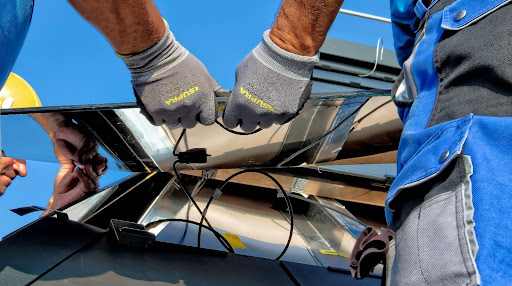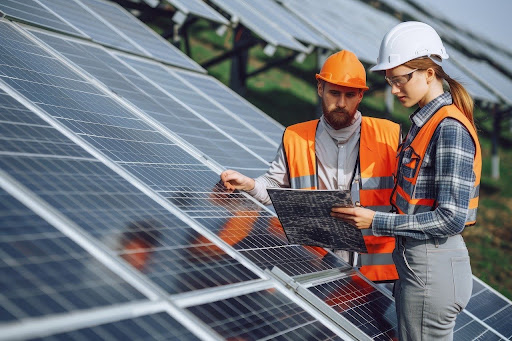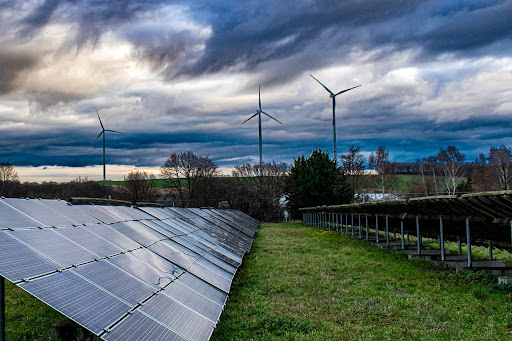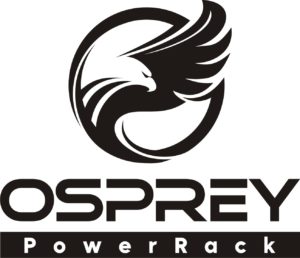Key Takeaways
- Solar panels increase property value and help businesses meet sustainability goals.
- A 10kW commercial solar panel system typically costs between $20,000 and $35,000 before any incentives.
- Federal and state incentives can reduce installation costs by 30% or more.
- Nuance Energy’s Osprey PowerRACK® is an excellent option for commercial projects, offering quick installation, scalability and adaptability to diverse soil conditions without the need for extensive site preparation.
10kW Commercial Solar Panel Benefits
A 10kW system is robust enough to power a small to medium-sized business, offering a significant reduction in electricity costs. This system size is particularly appealing for businesses with consistent energy demands.
A 10kW solar panel system can produce approximately 40 to 50 kWh of electricity per day, depending on geographic location and weather conditions. This output is sufficient to power various commercial operations, including lighting, HVAC systems, and office equipment.
Some key benefits of installing a 10kW solar panel system include:
- Reduction in electricity bills, allowing businesses to allocate funds elsewhere.
- Lower carbon footprint, contributing to environmental sustainability.
- Potential tax credits and incentives, reducing overall installation costs by at least 30%.
| Nuance Energy is your superior solution for Ground Mount solar. Our patented foundation technology Osprey PowerRACK® allows for rapid installation using only handheld tools, significantly reducing both time and costs compared to traditional racking systems. This cutting-edge technology works for residential and commercial installations, and Nuance Energy empowers solar installers to take back control of their installation schedules, control project COGS, gain market share, increase the speed of installation, and reduce the cost of labor. In contrast, a traditional ground mount is much more unpredictable, slower, and costly.
Find out how Nuance Energy can accelerate your solar projects with the Osprey PowerRACK® line, and boost your profitability. Contact us today to discuss our innovative ground-mount solutions. |
Cost Analysis of 10kW Commercial Solar Panels

A 10 kW commercial solar panel system can significantly reduce energy costs and carbon footprint, helping businesses enhance sustainability and savings.
Initial Investment and Installation Costs
The initial investment for a 10kW solar panel system typically ranges from $20,000 to $35,000 before any incentives or rebates. This price includes the cost of solar panels, inverters, mounting systems, and labor for installation.
Installation costs can vary significantly based on the complexity of the project, the type of installation, and local labor rates. On average, installation can account for 20-30% of the total system cost.
Consider the following factors when evaluating installation costs:
- Type and quality of solar panels and inverters
- Installation site and accessibility
- Local regulations and permit fees
Breakdown of Equipment Expenses
Here is a breakdown of typical equipment expenses:
| Component | Estimated Cost |
| Solar Panels | $12,000 – $15,000 |
| Inverters | $2,000 – $3,000 |
| Mounting Systems | $1,500 – $2,500 |
Besides the equipment and installation costs, businesses should also budget for maintenance, which is important for ensuring optimal system performance and longevity.
If you’re looking for a more innovative and cost-efficient alternative to traditional ground-mount solar systems, consider Nuance Energy’s Osprey PowerRACK®. Our system involves a quick installation process using patented earth anchor technology, which minimizes the need for extensive site preparation and equipment.
Efficiency and Performance Metrics
Efficiency refers to the percentage of sunlight that a panel can convert into usable electricity. For a 10kW system, high-efficiency panels are preferable as they generate more power in a smaller footprint, which is beneficial for businesses with limited space.
Performance metrics also include the temperature coefficient, which indicates how well a panel performs in high temperatures. A lower temperature coefficient is better, as it means the panel will lose less efficiency as temperatures rise. Therefore, selecting panels with a favorable temperature coefficient will maximize energy production, especially in warmer climates.
Installation Process and Key Considerations

Solar energy can significantly reduce operating costs for commercial businesses by lowering electricity bills and providing predictable energy expenses.
Site Assessment and Preparation
Site assessment involves a comprehensive evaluation of the installation location. This includes analyzing the roof’s structural integrity, identifying potential shading issues, and determining the best panel orientation for maximum sun exposure. For ground-mount systems, preparation involves clearing and leveling the installation site, digging trenches for wiring, and installing support structures such as posts or concrete foundations.
Local Regulations and Permits
Permits typically involve electrical and structural approvals, ensuring that the system meets safety and building codes. Engaging with local authorities early in the planning phase can prevent delays and streamline the installation process. Regulations vary significantly depending on the location, so it’s essential to work with an installer familiar with the local permitting process.
Hiring Qualified Installers
When selecting an installer, consider the following:
- Experience and track record in commercial solar installations
- Certifications and licenses, such as NABCEP certification
- Customer reviews and testimonials
A reputable installer will provide a detailed proposal, outlining the installation process, timeline, and expected energy savings. This transparency helps businesses make informed decisions and ensures that the project stays on track.
Maximizing Savings with 10kW Commercial Solar Panels
Calculating Potential Energy Savings
Calculating potential energy savings involves analyzing current energy usage and estimating the solar system’s output. By comparing these figures, businesses can determine the percentage of energy costs offset by solar power.
Solar energy can significantly reduce costs during peak demand periods when electricity prices are highest. Therefore, aligning solar production with peak usage times can maximize savings.
Integration with Battery Storage
Integrating battery storage with a solar system offers additional benefits, such as energy independence and increased savings. Batteries store excess solar energy generated during the day for use at night or during power outages, providing a reliable backup power source.
For businesses, battery storage can also help manage demand charges, which are fees based on peak electricity usage.
Impact on Business Utility Bills
By generating your own electricity, you can reduce your reliance on the grid, resulting in lower monthly expenses. Many businesses report saving up to 75% on their electricity bills after switching to solar.

Choosing the right brand and model for your 10kW solar panel system can make a significant difference in performance and reliability.
Is Nuance Energy’s Osprey PowerRACK® a Better Alternative for Commercial Solar Projects?
Nuance Energy’s Osprey PowerRACK® features an efficient installation process, allowing commercial projects to be completed quickly with minimal site preparation. Our system is designed to adapt to various soil conditions, eliminating the need for extensive site-specific modifications. This means that businesses can start benefiting from solar energy sooner, reducing downtime and operational disruptions during the installation phase.
Due to our patented earth anchor system, Osprey PowerRACK® minimizes the structural requirements for mounting, which will reduce construction costs.
Looking to make a sustainable choice for your business?
Talk to our team and get a quote for your upcoming project.
Frequently Asked Questions
How long does it take to install a 10kW solar system?
The installation of a 10kW solar system typically takes between one to three weeks, depending on the complexity of the project and weather conditions. The process includes site assessment, obtaining permits, equipment delivery, and installation.
What is the lifespan of a typical commercial solar panel?
Commercial solar panels generally have a lifespan of 25-30 years. During this period, they maintain high efficiency and reliability, providing consistent energy output. Most manufacturers offer warranties that guarantee performance for at least 25 years, ensuring that businesses can rely on their solar investment for the long term.
Are there financing options for commercial solar panels?
Yes, several financing options are available for businesses looking to invest in solar energy. These include solar loans, leases, and power purchase agreements (PPAs). Each option has its advantages and should be evaluated based on the business’s financial goals and cash flow considerations. Additionally, federal and state incentives can significantly reduce the upfront costs of solar installations.
What are some cost-effective options for commercial solar projects?
Nuance Energy’s Osprey PowerRACK® offers a cost-effective solution for commercial solar projects by enabling rapid installation and adaptability to various soil conditions, reducing overall labor and site preparation costs. This innovative system helps businesses maximize their investment in solar energy while minimizing long-term expenses.
Save Time & Money on Your Next Solar Project
Request a QuoteRECENT POSTS
- DPW Solar vs Nuance Energy Mounted Solar Options: Cost & Benefits
- Geotechnical Report Cost & Requirements For Solar Projects
- Are Solar Panels Worth It In Nevada? Costs & Options
- OSPREY PowerRack Ground Mount System Compatibility: Single- and Dual-Axis Trackers
- Rammed Earth Foundation For Solar Arrays: Cost, Pros & Cons
- Agrivoltaics Explained: Solar & Agriculture Combined
- Large Scale Solar Systems Options: Pros & Cons
- Best Solar Options For Farms & Agriculture: Cost, Pros & Cons
- Unirac vs MT Solar Mounted Options: Cost & Benefits
- IronRidge vs Grengy Mounted Solar Options: Cost & Benefits

